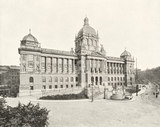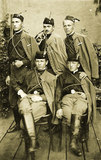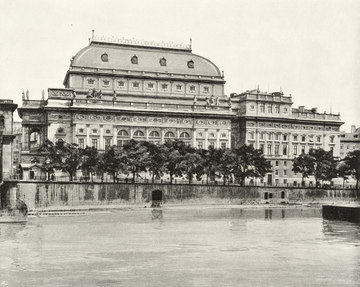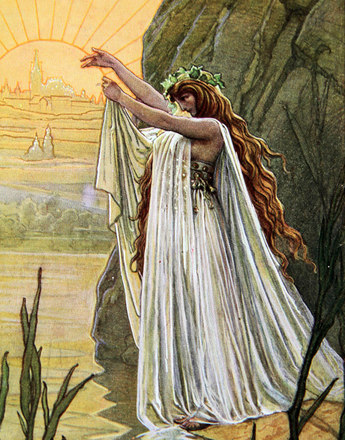-

Tschechisches Nationalmuseum auf dem Prager Wenzelsplatz, Fotografie, um 1898
Copyright: Schloß Schönbrunn Kultur-und Betriebsges.m.b.H./Fotograf: Alexander E. Koller
Partner: Schloß Schönbrunn Kultur- und Betriebsges.m.b.H. -

St Vitus Cathedral in Prague, entrance facade
Copyright: Martin Mutschlechner
-

Members of the Czech Sokol movement, photograph, around 1900
Copyright: IMAGNO/Austrian Archives
The Czech people’s national interpretation of history always accentuated the democratic element. The evolution of the nation was seen here as the endeavour to emancipate the broader mass of the people from feudal or national oppression. The opponents from the camp of those defending German hegemony in Bohemia designated the Czechs demeaningly as “a nation of plebeian lackeys”.
In contrast to the Poles and Magyars, the major vectors in the evolution of the nation were the bourgeoisie and the affluent farming community, and not the aristocracy, which professed allegiance to the country’s bilingualism and remained indifferent to the concept of nationality.
The national renaissance of the Czechs profited from the effects of the general economic and social progress that fundamentally changed the Habsburg Monarchy in the nineteenth century. Thus the Bohemian school system, separated linguistically, was deemed to be the best in the Monarchy. The growing literacy of a broad-based public created a new readership for the blossoming Czech literary production. National associations, magazines and publishing houses such as the Matice česká founded in 1831 propagated the now obligatory canon of national viewpoints.
Industrialisation and urbanisation generated a modern mass society with a socially diversified spectrum. Czech was no longer exclusively the language of the petty bourgeoisie and rural population, but also of a new middle class. Academics and entrepreneurs likewise began to profess allegiance to the Czech nation. One expression of the change was the “tilting” of erstwhile German-dominated towns and cities in favour of the Czechs: thus in 1861 the latter managed to attain the majority in the Prague Municipal Council.
This development was supported by the strongly pronounced presence of associations and cooperatives, which communicated national viewpoints to the broad-based public. First and foremost to be mentioned here is the gymnastics and sports union Sokol (Falcon), which acted as a tightly organised national strike force.
A triumph was celebrated in the division in 1882 of Prague University – founded in the Middle Ages by Charles IV – into two institutionally separate faculties with German, respectively Czech, as teaching languages. Now it was possible for Czechs to go through their educational career, all the way from elementary school to university graduation, in their mother tongue.
Not only this: the revivalists worked to enhance the nation’s honour in the cultural sphere as well. In 1873 an initiative was started to finish St Vitus’s Cathedral in Prague, which had remained unfinished since the fifteenth century. Comparable with the completion of Cologne Cathedral (as a symbol of German reunification in the nineteenth century), the Prague action was seen as a national tour de force and symbol of the reawakening of the Czechs.
In 1881 the proud Czech nation celebrated by opening the new building of the Prague National Theatre; proudly blazoned above the stage in golden letters was the device: “Národ sobě“ [approximately: Dedicated by the nation to the nation]. From then on the building on the banks of the Vitava (Moldau) became the leading home of drama and music with a genuine Czech note – the works of composers Bedřich Smetana and Antonín Dvořák may be named as examples.
In 1891 the new, opulent building of the National Museum – as an institution already the long-time centre of Czech academe – was completed in a dominating position on St Wenceslas Square in Prague. Now the prerogative of hegemony for Czech culture in the country’s capital had also found palpable expression in a building.
Translation: Abigail Prohaska
Hoensch, Jörg K.: Geschichte Böhmens. Von der slavischen Landnahme bis ins 20. Jahrhundert, München 1987
Kořalka, Jiří/Crampton, Richard J.: Die Tschechen, in: Wandruszka, Adam/Urbanitsch, Peter (Hrsg.): Die Habsburgermonarchie 1848–1918, Band III: Die Völker des Reiches, Wien 1980, Teilband 1, 489–521
Kořalka, Jiří: Tschechen im Habsburgerreich und in Europa 1815 bis 1914. Sozialgeschichtliche Zusammenhänge der neuzeitlichen Nationsbildung und der Nationalitätenfrage in den böhmischen Ländern (Schriftenreihe des Österreichischen Ost- und Südosteuropa-Instituts 18), Wien 1991
Křen, Jan: Dvě století střední Evropy [Zwei Jahrhunderte Mitteleuropas], Praha 2005
Rumpler, Helmut: Eine Chance für Mitteleuropa. Bürgerliche Emanzipation und Staatsverfall in der Habsburgermonarchie [Österreichische Geschichte 1804–1914, hrsg. von Herwig Wolfram], Wien 2005
-
Chapters
- The Czechs in the Habsburg Monarchy
- How Czechs evolved from Bohemians
- The Revivalists of the Nation
- Separate Ways: The Effects of the 1848 Revolution in Bohemia
- The Vectors of Czech National Identity
- The Call for Autonomy
- Hardening of the Fronts: The Czech Demand for the Bohemian Compromise
- Attempts at Solutions and Escalation: Language Conflict and Badeni Crisis
- The Czechs’ Spectrum of Parties
- The Lack of Alternatives: the Attitude of the Czechs towards the Habsburg Monarchy at the Outbreak of the War



